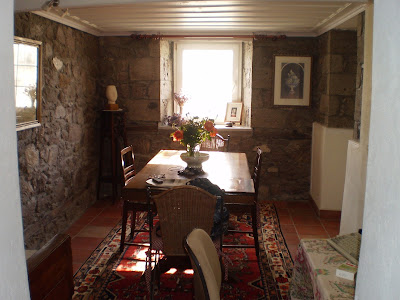Kalorizika: a good fate

Kalorizika :
This is a Greek
term of politeness that is hard to translate. You might say it to someone who has
acquired a new item, a new house, a new car. Speaking in English one would say:
‘Congratulations!’ Takis says it means ‘good establishing’, ‘good rooting’, others say it means ‘good fate’
'A house is not enough to ensure a good life you need a good environment and community around that house.'
We have now rooted deep in the soil of Myrina. I've gathered together a few of my favourite pictures to illustrated the progress we've made over the last fifteen years, as we've sent down roots on the island of Lemnos.
 |
| The house before I knew it, about thirty years ago |

Our Old Greek House –
rooted in history
Ancient houses on the
Our Old Greek Home – established in Myrina
 |
| Fifteen years agoTakis unlocked the door. |
 |
| This year we at last repainted that door! |
It was 2002 when I first travelled to Lemnos and got my first view of the house. It was winter
when we arrived at the front door by taxi. At first glance the building looked
imposing but on closer inspection the ‘mansion’ turned out to be less
impressive. The stucco was stained, all the windows were boarded up and a very
dilapidated balcony hung above the front door.
Our Old Greek Home – built and renovated by local
Lemnians
Takis had
to get used to the local economy. He became familiar with the owners of the
small shops and warehouses, and they became familiar with his project. He discovered that he was known as ‘The
Australian’ by the building suppliers. And it was because he got a firm quote
for materials and then paid up-front, not waiting until the job was finished
and then delaying payment or haggling over the price, he was soon not only
welcomed he was respected.
Our Old Greek Home – surrounded by the past but
established today


I was a devote collector of
‘Mediterranean-style’ pictures which I pasted in a book under various headings,
‘kitchen’, ‘bedrooms’, ‘sitting room’, etc. Of course I had to wait for the big
projects (roof, floors, windows) to be finished before putting any of these
decorating ideas into practice but this didn’t deterred me, for my scrapbooks
of ideas could always do with a little more fine tuning. When the building work was finished I first painted
the interior, and then began work doing the finishing touches. One of these was
the painted the ceilings another was adding lace curtains.


What
had fascinated me in pictures of old Greek houses was the way that the wooden
ceilings and cornices were often highly decorated. During the 18C there were groups of craftsmen who
travelled from place to place across a wide geographical area building these
homes and other structures. Many of these sinafia were seasonally mobile teams,
often they came from Epirus ,
western Macedonia , Thrace and central Peloponnese .
It seems probable that these were the master craftsmen who then employed locals
to work for them. I wanted to keep our house light and planned to paint walls
and woodwork cream however I thought we could copy this old tradition and put
colour onto the ceilings. Our ceilings are not as complicated in design or in
colour as those of old but they give each room a distinctive atmosphere.


No comments:
Post a Comment